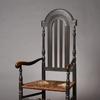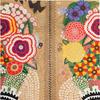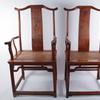The Museum of Russian Icons Presents "The Long Way Home: A Photographic Journey with Gordon Lankton"
- CLINTON, Massachusetts
- /
- July 22, 2020
CLINTON, MA– The Museum of Russian Icons presents The Long Way Home: A Photographic Journey, an exhibition featuring more than 40 stunning photographs taken by Museum Founder Gordon B. Lankton during a life-changing motorcycle trip to 24 different countries across Europe and Asia in the mid-1950s. The exhibition will be on view now through September 27, 2020.
On November 6, 1956, armed with a camera, maps, passports, C-Rations, a budget of $5.00 per day ($3 food, $1 sleeping, $1 for gas and everything else) and little else, 25-year-old Lankton left Frankfurt, Germany on an NSU motorcycle and began an adventure that would influence the path he would take for the next 50 years.
“It is particularly fitting that we reopen the Museum with an exhibition of photographs by our founder–whose cultural curiosity, sense of adventure, social entrepreneurship, and generous spirit are at the core of our institution,” says Executive Director Kent Russell. “We eagerly await welcoming visitors back to our galleries.”
Embarking on Adventure
In 1953, while studying Engineering at Cornell University, a 22-year-old Gordon B. Lankton traveled to Japan on an exchange program to study relations between Japan and the US. Gordon immersed himself in Japanese culture and ignited his curiosity, passion, imagination, and quest for knowledge of the world. With a desire to explore the world, and to understand his place in it, Gordon began extensive planning to execute a trip around the world, but first, he had to fulfill his two-year military commitment.
Gordon lobbied hard for his service to be completed in Europe and prevailed. Deployed to Germany, he immersed himself in absorbing every detail of German culture, language, and way of life. He began questioning whether to pursue a career as an engineer or in the Foreign Service. Gordon continued his meticulous plans for his trip, with a route starting in Germany and ending in Japan and challenged himself to meet two objectives:
- To see the world
- To visit the American embassies in all of the countries where he traveled and talk to Foreign Service Officers to see what their jobs entailed and what kind of lives they were leading
The first week in November 1956 turned out to be one of the most eventful: America elected Dwight Eisenhower to a second term as President. The Hungarians revolted against Russian rule and fled their country as refugees along the highways of Western Europe. The British and French bombed ships in the Suez Canal when the Egyptians tried to nationalize the canal that ran through their country. The entire Middle East was in turmoil over this issue, which made Gordon’s visits to Syria, Lebanon, Jordon, Israel, and Egypt impossible.
The Journey’s Challenges
From shopkeepers, farmers, embassy employees, dignitaries, and other travelers, Gordon engaged with everyone he encountered along the way. Each conversation held equal weight and presented him with an opportunity to glean intimate details of the world around him. These experiences played an integral role in his trip and his future.
He learned to manage the intricacies of each countries’ regulations and bureaucracies. Witnessing various governments’ effects on its citizens explained how each country he visited fit into the larger world.
Gordon’s journal describes many challenging events. His passport and money were stolen in Burma; in Calcutta, he encountered complicated local government regulations, and an intricate Indian bureaucracy when he wanted to sell his motorcycle. He managed these situations by partnering with sympathetic allies to assist him in negotiating the challenges he found along the way, skills that benefitted him throughout his career.
Modes of Travel
Tales of an American traveling on a motorcycle preceded Gordon’s arrival in many countries. Villagers would come out to observe this foreign traveler and to admire his celebrated motorcycle, the subject of curiosity and admiration in many remote places.
Gordon began the journey in the company of his close friend George and his wife Judy, friends from Cornell, who traveled by car. Embarking on separate routes from Turkey, they reunited in New Delhi. Delayed in India, due to “government bureaucracy,” they parted ways, and Gordon was left in Calcutta to continue his travels alone.
Along the way, Gordon’s accommodations were varied. He would find a bed and meals at the end of a day of traveling and stop when he was tired. He slept outside, at youth hostels, and on occasion, he received invitations to private homes, meticulously recording his encounters, experiences, and budgets in his journals.
Reaching Calcutta India in March 1957, he was obliged to sell the motorcycle, as the remaining trip required sea travel. From this point onward, trains, planes, trucks, boats, and walking were the new order of the day, which afforded even more interactions with the local people.
The Start of an Art Collection
With a passion for the arts and a keen eye for quality, Gordon sought out the “pure artists” of each country he visited. He admired the craftsmanship and honored the individual artist. Through the lens of an engineer, Gordon was fascinated by how artists made things. He often disregarded the commercial city shops and what was offered there and sought out studios and workshops where he could meet and talk with artists.
All along the journey, Gordon would purchase art and send it home to Peoria by mail. He met individuals who, through conversations, would reveal characteristics of their cultures. Many of these conversations were with artists and craftspeople. These encounters resulted in Gordon purchasing works of art that had personal meaning for him, and he retained fond memories of the individuals who created these works of art.
The Journey Ends
Gordon arrived in Tokyo, Japan, on July 12, 1957. He was greeted by his friend Taizo, whom he knew from his previous trips to that country as a representative of the Cornell University Student Government. Taizo was a welcome sight for a traveler alone in the world for eight months.
The next few weeks were spent in the hospitality of other friends as he rediscovered Japan. Some of them became trusted, and loyal business colleagues as Gordon established his plastics business over the next six decades. His travels had a profound influence on his personal world view and gave him the tools that enabled him to build a successful, international company.
Gordon had realized his goal of a “trip around the world,” and on July 31, 1957, he boarded a plane in Tokyo headed for the US. It would be the first time he was home in nearly three years.
After the Adventure
In the 1960s, Gordon went to work as a plastics engineer at Nypro, an international injection molded plastics company in Clinton, Massachusetts, eventually becoming President. After the fall of the Iron Curtain, Gordon visited one country he wasn’t able to during his 1950s trip because of the Cold War–RUSSIA! In 1989, on a business trip to Moscow, Gordon purchased his first icon at an open-air market. His private collection quickly grew, eventually giving birth to the idea of starting a museum. Gordon chose Clinton for the location to give back to the community that had supported him, and the Museum of Russian Icons opened in October 2006.
In 2007 Gordon’s book The Long Way Home was released, chronicling, in his photos and words, his trip of 27,000+ miles to 24 countries in 267 days. He visited, in chronological order: Germany, Austria, Italy, Yugoslavia, Greece, Turkey, Syria, Iraq, Iran, Pakistan, India, Ceylon, Nepal, Burma, Thailand, Laos, Vietnam, Cambodia, Malaysia, Singapore, Indonesia, Philippines, Hong Kong, and Japan.
RELATED PROGRAMMING
Zoom Webinar: Exploring The Long Way Home Exhibition
Saturday, August 15, 1:00-2:30 pm EST (Please note, times are for Eastern Standard Time zone)
Members free, Nonmembers $5. A link to the webinar will be sent to participants on the morning of the program. Limit: 100 participants.
Register at https://museumofrussianicons.charityproud.org/EventRegistration/Index/3979
Over a year’s worth of planning and preparation has gone into creating the exhibition The Long Way Home: A photographic journey with Gordon Lankton. Museum CEO/curator Kent Russell, consultant Karen Lankton, and exhibition curator Chris Stratford discuss the process of translating The Long Way Home from book to exhibition, including mapping Gordon’s motorcycle journey and selecting the photographs.
ABOUT THE MUSEUM
The Museum of Russian Icons inspires the appreciation and study of Russian culture by collecting and exhibiting one of the world’s largest collections of Russian icons — sacred paintings used for worship in the Orthodox tradition. With more than 1,000 icons and related artifacts spanning six centuries, the Museum offers a unique and personalized experience rich with art, history, and culture.
The Museum serves as a leading center for research and scholarship through the Center for Icon Studies and other institutional collaborations. It is the only Museum in the US dedicated to Russian icons, and it is the largest collection of icons outside of Russia.
In order to safely welcome visitors to view the newly reinstalled permanent collection and special exhibitions, the Museum will be implementing new hours, timed ticketing, and variety of protocols. A maximum of 20 guests will be allowed in the Museum during each time slot. Reservations are required and can be made by calling Visitor Services at 978.598.5000. As well as limiting hours and number of guests, the Tea Room and Auditorium will be closed since there is not enough room for safe social distancing.
MUSEUM HOURS
Friday, Saturday, and Sunday, 11am-5pm. Closed Monday–Thursday
Four daily time slots: 11:00am-12:30pm; 12:30-2:00pm; 2:00-3:30pm; 3:30-5:00pm.
Admission: Adults $10, seniors (59+) $7, Students $5, Children (3-7) $5, Children under 3 Free.
Follow the Museum of Russian Icons on Facebook, Twitter, and Instagram and Youtube, for the latest updates on the Museum, spotlight tours, children’s storytime, and read what the docents are saying about individual items from the collection.
Visit the website, www.museumofrussianicons.org, home of the Online Collection (including research papers on individual icons), a virtual tour of the Museum, the Journal of Icon Studies, and the British Museum’s Catalogue of Byzantine and Greek Icons.
Contact:
Nina J BergerMs.
6175431595
ninajberger@gmail.com
203 Union Street
Clinton, Massachusetts
info@museumofrussianicons.org
978.598.5000
http://www.museumofrussianicons.org/
About Museum of Russian Icons
The Museum of Russian Icons inspires the appreciation and study of Russian culture by collecting and exhibiting icons and related objects; igniting the interest of national and international audiences; and offering interactive educational programs. The Museum serves as a leading center for research and scholarship through the Center for Icon Studies and other institutional collaborations. It is the only museum in the US dedicated to Russian icons, and it is the largest collection of icons outside of Russia. Museum hours: Tue. - Fri., 11AM to 4PM, first Thurs of the month to 8PM, Saturday and Sunday 11AM to 5PM, closed Mondays. Admission: Adults $10, seniors (59+) $7, Students $5, Children (3-7) $5, Children under 3 Free. For more information please visit museumofrussianicons.org.







_-Closing-the-Distance_100x100_c.jpg)








